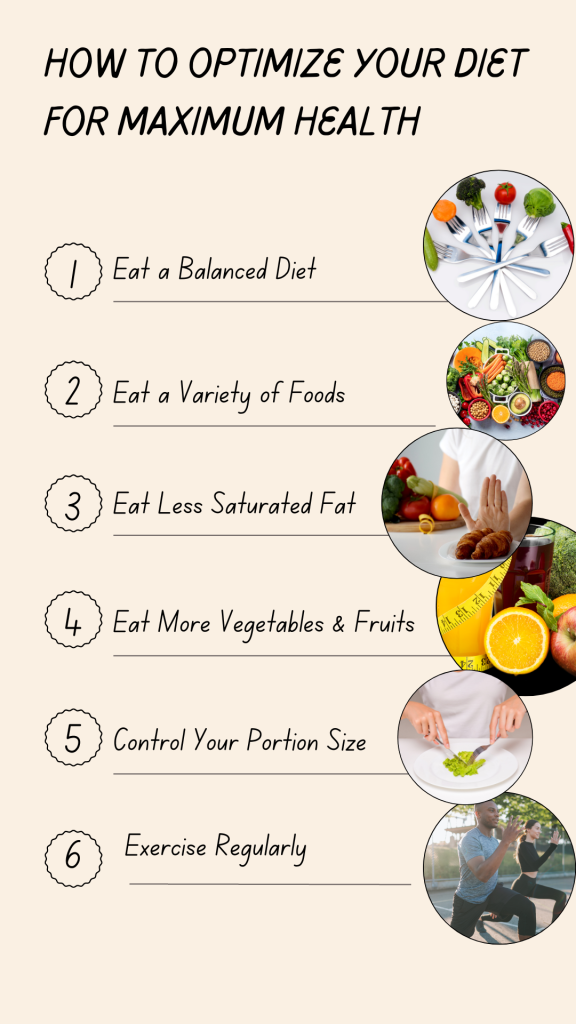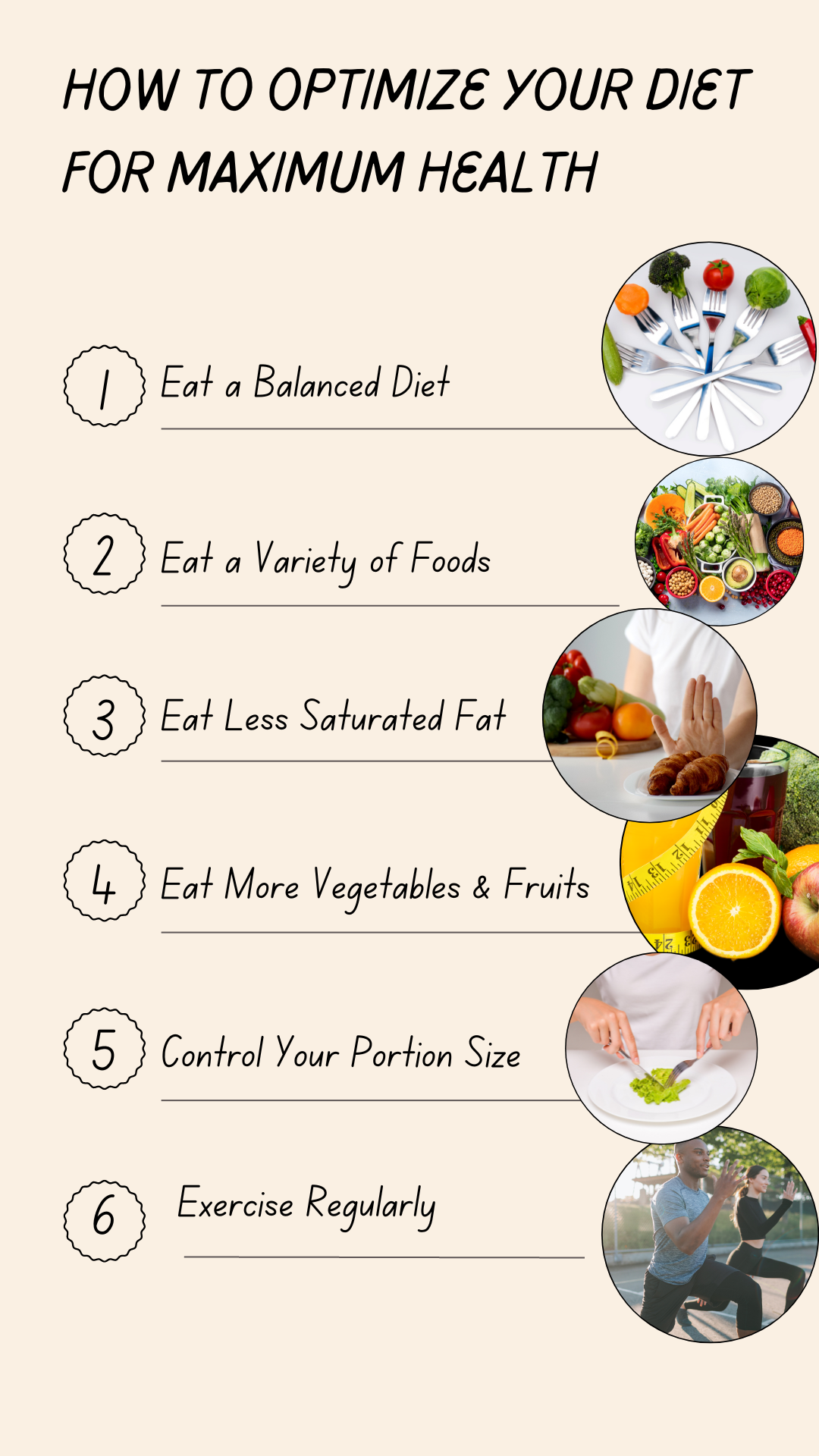
Visits: 100
A healthy diet can make you feel at your best, boost your energy and help you maintain a healthy weight. But it can also reduce your risk for certain chronic diseases.
Optimizing your diet doesn’t have to be hard, but it can take a little time and effort. Here are a few simple tips you can use everyday to improve your nutrition.
Eat a Balanced Diet
Eating a balanced diet ensures the body receives all the nutrients it needs to function properly. This helps protect against chronic diseases such as diabetes, heart disease, and cancer, and maintains mental health.
A balanced diet also enables you to maintain a healthy weight. To optimize your diet for maximum health, eat a variety of foods from each of the five food groups recommended by the USDA.
Keep in mind that a balanced diet should also include protein and healthy fats. Choose a wide range of vegetables, fruits, whole grains, and lean meats to ensure that you get all the nutrients you need.
Limit your intake of saturated fat and salt. Saturated fats increase your blood cholesterol levels and raise your risk for cardiovascular disease.
Likewise, cut back on sugary beverages like soda and energy drinks. Stay hydrated by drinking lots of water.
Consuming a balanced diet also helps build strong immune systems. The vitamins and minerals in a healthy diet can prevent fatigue, infections, and other chronic diseases.
Choosing healthy and balanced foods can be hard, but it’s important to eat well every day. If you have trouble balancing your calories, ask your doctor or dietitian for a personalized meal plan that will meet your nutritional needs.

Eat a Variety of Foods
Eating a variety of foods is one of the most important things you can do to optimize your diet for maximum health. Not only will you get a wide range of vitamins and minerals, but you’ll also prevent yourself from becoming bored with your diet.
A variety of whole food sources is important for getting a wide array of nutrients, including antioxidants and phytonutrients that are only found in fruits and vegetables. For example, a kale salad made with carrots and tomatoes is packed with heart-healthy lycopene, as well as plant-based omega-3s from walnuts.
However, eating a wide range of different foods can be a challenge for many people. This is especially true if you aren’t particularly good at making healthy food choices or have a difficult time sticking with a diet full of fresh foods.
While it’s not a hard and fast rule, most experts recommend that you include a wide range of foods in your diet. This is because they can provide a wide range of vitamins and minerals, and help keep you feeling energized.
In the UK, dietary guidelines divide foods into 5 groups: starchy carbohydrates, fruit and veg, milk or dairy alternatives, proteins and fats. Those groups are designed to provide the body with essential nutrients that will improve your health and reduce your risk of diseases, such as cancers, cardiovascular disease and diabetes.
Eat Less Saturated Fat
One of the best ways to optimize your diet for maximum health is to eat less saturated fat. This is because saturated fat can increase your cholesterol levels, which is linked to a higher risk of heart disease and stroke.
Saturated fats come from foods like red meat, butter, pastries, and full-fat dairy products. They are also found in tropical oils, such as coconut and palm.
The 2015-2020 Dietary Guidelines for Americans recommend limiting saturated fat intake to no more than 10% of your daily calories and replacing it with unsaturated fats when possible.
However, a diet high in saturated fat can also cause weight gain and increase your risk of developing certain chronic conditions. So, if you do choose to indulge in high-fat foods occasionally, limit the portion size and make sure it doesn’t exceed your daily budget for saturated fat.
Another key way to minimize your saturated fat intake is by reducing the amount of fat and oil you consume. This can include avoiding stick margarine, shortening, lard and other industrially produced oils.
In addition, you should also avoid eating trans fats. These are fats found in fried foods and bakery goods that can increase your total and low-density lipoprotein (bad) cholesterol. By replacing the saturated fat in your diet with polyunsaturated and monounsaturated fats, you can reduce your risk of cardiovascular disease. And the same goes for omega-3 fatty acids, which can reduce inflammation and help prevent disease.
Eat More Vegetables & Fruits
Eating more vegetables and fruits can help you maintain good health, decrease the risk of disease and reduce the amount of fat you eat. They are low in calories, and contain many nutrients that promote heart health and reduce your risk of cancer, type 2 diabetes and high blood pressure.
According to the USDA, adults should get at least two cups of fruits and two cups of vegetables per day to maintain a healthy diet. Vegetables are also a source of important vitamins and minerals, including fiber, potassium, folate and vitamin A.
While most people eat too little vegetables, eating more of them can help you achieve the recommended intakes and improve your health. Vegetables are a great source of fiber, which can help you feel full and prevent overeating.
To optimize your diet, start by exploring the produce section at the grocery store and experimenting with new vegetables and fruits. You’ll be surprised at the variety of foods you can find, and you may discover a new favorite.
You can make veggies part of meals or add them to recipes you already cook. Try using different cooking methods, like steaming and adding low-calorie or low-fat dressings.
Fruits are also a great way to add color to your diet. In addition to containing antioxidants, many fruits have phytochemicals that can help prevent cancer and other diseases. The American Heart Association recommends eating a wide range of fruits and vegetables to ensure you’re getting the recommended daily dose of vitamins, minerals and other nutrients.
Control Your Portion Size
Having a good understanding of portion size is essential for eating healthily and staying at your ideal weight. Eating too much is a common problem that leads to weight gain, which can increase your risk of medical problems later in life.
The best way to control your portions is to become familiar with the recommended serving sizes of foods, explains Jackie Baumrind, M.S., a senior dietitian at Selvera Wellness. You can do this by reading labels and using the proper tools to measure out your food.
Use small plates and bowls when you serve your meals to help you feel full faster. Studies show that people tend to consume more when food is served on large dishes.
It’s also important to understand that portion control does not mean counting calories. While it may be helpful for specific health and fitness goals, most people can follow a healthy eating plan without having to count calories every day.
Practicing portion control will become a habit over time, which is especially useful when you’re eating out. Avoid platters of food that you can “pick” at, or ask for half or smaller portions. And make sure you put away leftovers in portion-controlled amounts.
Exercise Regularly
Exercise is an important part of a healthy diet, and it can help you control your weight and prevent illness. It’s also beneficial for your mental health, improving self-esteem, sleep quality and mood.
Getting regular exercise also lowers your risk of heart disease and other chronic diseases, such as high blood pressure, diabetes, depression, osteoporosis (bone loss), and stroke. It increases your energy and reduces stress, anxiety, and fatigue.
In addition to burning calories, exercise can improve muscle mass and strength and increase your overall fitness level. It can also help you lose weight, especially belly fat.
It can also lower your cholesterol levels, and it may cut your risk of some cancers. In addition, it can make you more comfortable in your daily activities, especially if you have arthritis or other physical disabilities.
The Centers for Disease Control recommends 150 minutes of moderate-intensity aerobic activity per week to maintain or improve your health. You can include other types of exercises, such as weight training, to get even more benefits.
You should start slowly and gradually increase the amount of time and number of days you exercise each week. You should also discuss your workout with your doctor before starting any new program or if you have medical conditions such as a heart condition or arthritis.
It’s also important to choose exercises that involve several muscles at once, such as sprints, box jumps, sled pulls/pushes, kettlebell swings, cleans and presses, ball slams, battle ropes and walking lunges. These movements boost your heart rate and musculature all at once, and they’ll help you burn more calories post-workout.
Originally posted 2023-03-02 21:15:38.


